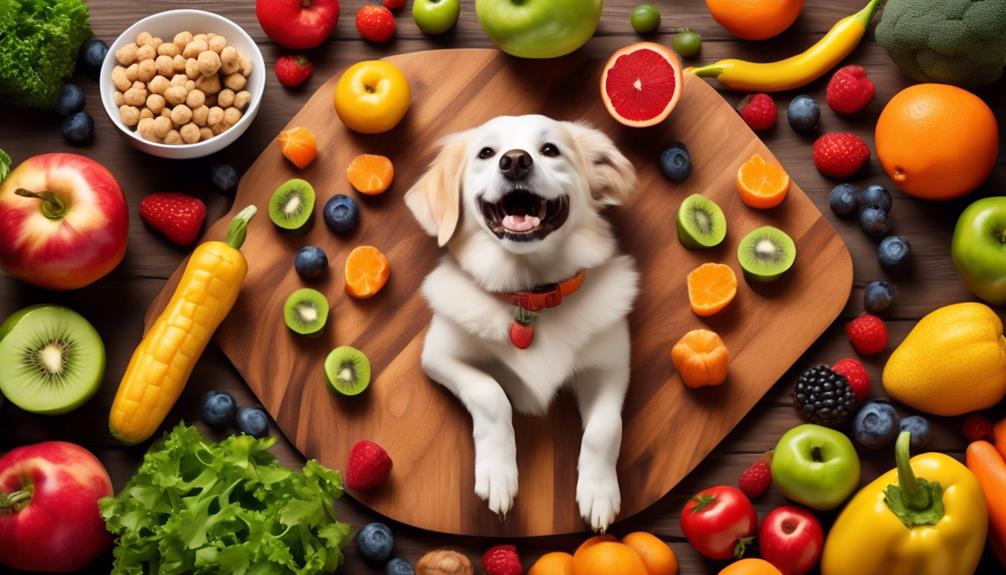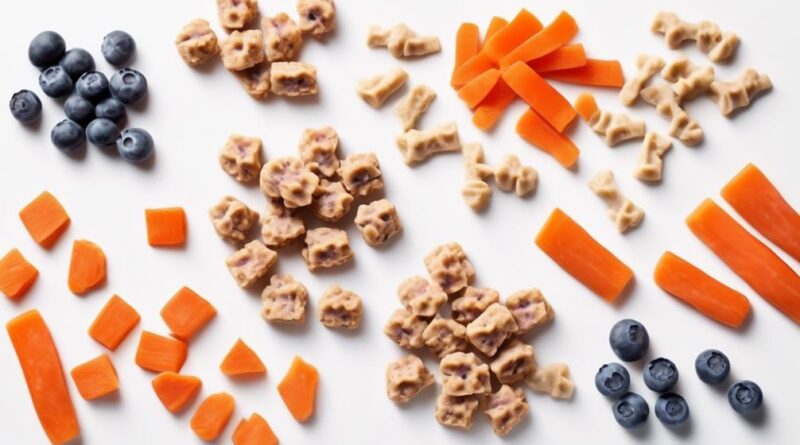What Are Nutritious Training Treats for Dogs?
When training your dog, you want to ensure that the treats you use are not only tasty but also nutritious. But with so many options available, how do you know which ones are the best for your furry friend?
From nutrient-rich treat options to homemade recipes and low-calorie snack ideas, there are various considerations to keep in mind when choosing the right training treats for your dog.
So, what are the key factors to consider when selecting the most beneficial treats for your pup's training sessions?
Importance of Healthy Training Treats

To effectively train your dog, it's crucial to use healthy treats that provide the necessary nutrients for their overall well-being. Nutrient balance plays a key role in maintaining your dog's health, and using treats with a good nutrient balance can contribute to their overall diet. When selecting treats, consider the proportions of protein, fats, and carbohydrates to ensure your dog receives a well-rounded diet even during training sessions.
Portion control is equally important. Treats should be small enough that your dog can consume them quickly without getting too full or losing interest in the training. By controlling the portion size, you can avoid overfeeding your dog while still providing them with a rewarding incentive during training.
When training your dog, using treats that offer a healthy nutrient balance can support their overall well-being. Look for treats that contain high-quality proteins, such as chicken or beef, to support muscle development and energy levels. Additionally, treats with healthy fats, like omega-3 fatty acids, can contribute to a shiny coat and overall skin health. Carbohydrates from sources like sweet potatoes or peas can provide a source of energy for your dog during training sessions.
In addition to nutrient balance, portion control is vital to prevent overfeeding. Small, bite-sized treats are ideal for training sessions, ensuring your dog can quickly consume the treat and remain focused on the training. By incorporating healthy, properly portioned treats into your training routine, you can effectively reinforce positive behaviors in your dog while supporting their nutritional needs.
Nutrient-Rich Treat Options
When selecting nutrient-rich treats for your dog's training, prioritize options that offer a well-balanced combination of proteins, healthy fats, and carbohydrates to support their overall health and energy levels.
Meat jerky is an excellent choice for training treats as it's packed with high-quality protein, which is essential for muscle growth and repair. Look for jerky made from lean meats like chicken, turkey, or beef to ensure a healthy option for your furry friend.
Additionally, cheese cubes can be a great source of protein and healthy fats for your dog. Opt for low-sodium options and cut them into small, bite-sized pieces for convenient training rewards. Cheese also provides essential nutrients like calcium, which supports bone health in dogs.
When it comes to carbohydrates, consider treats that incorporate whole grains such as oats or quinoa. These grains offer a slow-release source of energy, which can be beneficial during longer training sessions.
Incorporating a variety of nutrient-rich treat options into your dog's training routine ensures that they receive a well-rounded diet while staying motivated and engaged during training.
Remember to monitor portion sizes to account for these treats within your dog's overall daily caloric intake to maintain a healthy weight.
Homemade Treat Recipes
Consider incorporating nutritious, homemade treats into your dog's training routine to provide them with wholesome, flavorful rewards. Making your own dog treats is easy and affordable, and it allows you to control the ingredients, ensuring that your furry friend gets the best.
Here are a couple of tasty, customizable recipes that your dog will love.
One easy and affordable homemade treat is peanut butter and banana frozen bites. Mash a ripe banana and mix it with natural peanut butter. Spoon the mixture into ice cube trays and freeze. This simple yet delicious treat isn't only customizable but also provides a refreshing snack for your pup, especially on hot days.
Another great option is homemade sweet potato chews. Slice sweet potatoes into thin strips, toss them in a bit of coconut oil, and bake them until they're crispy. Sweet potatoes are packed with nutrients and fiber, making them a healthy and tasty treat for your dog. Plus, you can customize the thickness of the slices to adjust the chewiness of the treat.
Low-Calorie Training Treats
As you explore ways to enhance your dog's training routine with homemade treats, now focus on incorporating low-calorie options to keep your furry friend healthy and motivated. When choosing low-calorie training treats for your dog, it's essential to opt for options that aren't only nutritious but also delicious to keep your pup engaged during training sessions.
Here are some ideas for low-calorie training treats:
- Frozen Green Beans: These low-fat options aren't only low in calories but also provide a satisfying crunch for your dog to enjoy.
- Carrot Slices: Carrots are a great low-calorie option that provides essential nutrients and promotes dental health.
- Air-Popped Popcorn: Plain, unsalted, and unbuttered air-popped popcorn can be a delightful low-calorie training treat for your dog.
- Small Apple Slices: Apples are a healthy and low-calorie option that can be cut into small, bite-sized pieces for portion control during training sessions.
When incorporating low-calorie training treats into your dog's routine, it's important to consider portion control. Even low-calorie treats can contribute to weight gain if overfed. Always be mindful of the number of treats given to your dog throughout the day, and adjust their regular meals accordingly to accommodate the additional calories from the training treats.
High-Protein Snack Ideas
For high-protein snack ideas to enhance your dog's training, explore options that are both nutritious and enticing to keep your furry friend motivated and healthy.
When it comes to high-protein snacks for your dog, consider plant-based options like peanut butter or pumpkin seeds. These can be great sources of protein and healthy fats, which are essential for your dog's overall well-being. Additionally, if your dog has a nut allergy, opting for nut-free alternatives such as edamame or chickpeas can provide a protein-packed snack without any potential allergens.
Sustainable sources should also be a consideration when selecting high-protein snacks for your dog. Look for treats that are made from ethically sourced ingredients, such as free-range chicken or grass-fed beef. These options not only provide a high-quality protein source for your dog but also support sustainable and humane practices in the food industry.
Another high-protein snack idea is incorporating small amounts of cooked quinoa or lentils into your dog's treat routine. These plant-based proteins aren't only nutritious but also easy to digest for dogs. They provide an alternative to animal-based protein sources, which can be beneficial for dogs with specific dietary needs or for pet owners looking to introduce more plant-based options into their dog's diet.
Training Treats for Sensitive Stomachs
If your dog has a sensitive stomach, opt for easily digestible, low-fat training treats to avoid any potential digestive issues during their training sessions. It's important to prioritize digestive health and choose treats that are gentle on the stomach. Here are some options to consider:
- Limited ingredient treats: Look for treats with minimal, easily identifiable ingredients. These treats are less likely to contain any irritants that could upset your dog's stomach.
- Single protein source treats: Treats with a single source of protein can be beneficial for dogs with sensitive stomachs. They're often less likely to cause digestive upset compared to treats with multiple protein sources.
- Grain-free treats: Some dogs with sensitive stomachs may benefit from grain-free treats. These treats can be easier to digest and may be a good option for dogs with grain sensitivities.
- Novel protein treats: Consider treats made from novel protein sources such as duck, rabbit, or venison. These alternative protein options can be less likely to trigger allergies or digestive issues in sensitive dogs.
When selecting training treats for a dog with a sensitive stomach, it's essential to consider their digestive health and prioritize allergy-friendly options. By choosing treats that are easy on the stomach and less likely to cause allergic reactions, you can ensure that your training sessions are both effective and comfortable for your furry companion.
Natural and Organic Options

Consider incorporating natural and organic training treats into your dog's routine to provide wholesome rewards during their training sessions. When choosing treats for your furry friend, look for options that are sustainably sourced and ethically produced.
Sustainable sourcing ensures that the ingredients used in the treats are obtained in a way that doesn't harm the environment or deplete natural resources. Ethical production means that the treats are made in a manner that respects animal welfare and the well-being of the workers involved in the process.
Look for training treats that contain organic ingredients, which are grown without synthetic pesticides or fertilizers, making them a healthier choice for your dog. Organic options often contain higher levels of beneficial nutrients, as they're produced in a more natural and nutrient-rich environment. Additionally, organic treats are free from artificial additives, colors, and flavors, reducing the risk of allergies and digestive issues in your dog.
When it comes to sustainable sourcing, consider treats made from ingredients that are responsibly harvested or farmed. This ensures that the treats support environmentally friendly practices and contribute to the well-being of the ecosystems from which the ingredients are derived.
Avoiding Harmful Additives
When it comes to ensuring your dog's training treats are wholesome and beneficial, it's essential to steer clear of harmful additives that can compromise their health and well-being. As a responsible pet owner, you want to provide the best for your furry friend. Here's what to watch out for when selecting training treats for your dog:
- Avoiding Artificial Colors: Look for training treats that are free from artificial colors. These additives serve no nutritional purpose and can potentially have negative effects on your dog's health.
- Avoiding Artificial Flavors: Opt for treats that are free from artificial flavors. Natural flavors derived from high-quality ingredients can provide a more satisfying and healthy taste for your dog.
- Preservative-Free Options: Choose training treats that are preservative-free. Natural preservatives such as tocopherols (Vitamin E) and rosemary extract are healthier alternatives to chemical preservatives.
- Read the Ingredients List: Take the time to read the ingredients list on the packaging. Avoid treats containing additives such as BHA, BHT, and propylene glycol, as these may have adverse effects on your dog's well-being.
Frequently Asked Questions
Can Training Treats Be Used for Dogs of All Ages, or Are There Specific Treats for Puppies, Adult Dogs, and Senior Dogs?
You can use training treats for dogs of all ages, but it's important to consider the specific needs of puppies, adult dogs, and senior dogs.
When choosing treats, look for options that work for picky eaters and consider tailoring treats for specific breeds.
For puppies, soft, small treats are best, while adult dogs may prefer crunchy treats.
Senior dogs may benefit from softer treats that are easier to chew.
Are There Any Training Treats That Can Help With Specific Health Conditions, Such as Joint Issues or Dental Health?
You can find training treats that cater to specific health needs, such as joint supplements for dogs with joint issues, dental chews for dental health, allergy-friendly treats for dogs with allergies, weight management treats for dogs needing to manage their weight, and breed-specific treats tailored to your dog's breed.
These options can provide not only a tasty reward for your pup during training, but also support their overall health and wellness.
How Often Should Training Treats Be Given to Dogs During Training Sessions, and Are There Any Potential Negative Effects of Overfeeding Treats?
When training your dog, it's important to find the right balance in treat rewards. Overfeeding treats can lead to potential negative effects like weight gain or digestive issues. To avoid this, consider the frequency of treat rewards in training.
It's best to use treats strategically and in moderation to reinforce positive behaviors without overindulging. Remember, consistency and timing are key in training, so choose your treat moments wisely.
What Are Some Creative Ways to Incorporate Training Treats Into a Dog's Daily Routine, Beyond Just Using Them for Training Sessions?
To incorporate treats into your dog's daily routine, you can use them during exercise to reward good behavior and motivate movement.
You can also use treat-based enrichment activities, like puzzle toys or treat-dispensing balls, to keep your dog mentally stimulated and engaged.
These activities not only provide mental and physical stimulation but also help strengthen the bond between you and your furry friend.
Are There Any Specific Ingredients or Flavors That Dogs Tend to Prefer in Training Treats, and How Can Owners Determine Their Dog's Preferences?
To determine your dog's treat preferences, try offering a variety of flavors and observing which ones they enjoy most.
You can also pay attention to their reactions during training to see which treats motivate them the most.
Training treat alternatives like carrots, blueberries, or small pieces of cooked meats can be nutritious options that dogs tend to enjoy.
It's important to consider your dog's individual tastes and any dietary restrictions when selecting training treats.
Conclusion
So, when it comes to training your furry friend, don't forget the importance of healthy treats.
Look for nutrient-rich options, consider making some homemade recipes, and keep an eye out for low-calorie and high-protein options.
If your pup has a sensitive stomach, there are treats tailored to their needs, and natural and organic options are always a good choice.
Just be sure to avoid harmful additives, and you'll have a happy and healthy training session with your pup.
